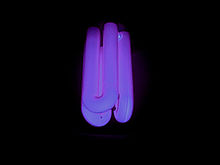Wood lamp
The Wood lamp , also known as black light lamp , is a special fluorescent lamp that primarily emits long-wave ultraviolet radiation ( black light / UV-A) and only a small amount of visible light in the blue-violet range of the color spectrum . The Wood lamp was named after the American physicist Robert Williams Wood , who developed it in 1903. In the medical field of dermatology, it is used for the early detection of various skin diseases. In forensic medicine , for example, it can be used to detect blood and semen .
Areas of application
dermatology
With the use of the Wood lamp in dermatology, fluorescent foci of diseases and pigment changes on the skin can be examined. In certain dermatophytes it comes in a darkened room to a yellow-green fluorescence by tryptophan - metabolites caused these fungi. This examination method was introduced into mycological diagnostics by Margarot and Deveze in 1925 . Bacterial pathogens such as pseudomonads and Propionibacterium acnes also lead to fluorescence. Corynebacterium minutissimum produces a coral red glow.
Neuropaediatrics
The Wood lamp enables or improves the early detection of trend-setting pigment changes in neurocutaneous syndromes such as white spots in tuberous sclerosis (tuberous sclerosis complex).
Forensic medicine
In forensics , under the light of the Wood lamp, especially when luminol is used at the same time , such traces can be made visible through the fluorescence of blood and sperm . However, this detection method has only a limited reliability due to some significant limitations and deficiencies.
Individual evidence
- ↑ J. Margarot and P. Deveze: Aspect de quelques dermatoses en lumière ultraparaviolette - note préliminaire . In: Bulletin de la Société des sciences médicales et biologiques de Montpellier . tape 6 , 1925, pp. 375-378 .
- ↑ Other bacteria - Erythrasma. In: Otto Braun-Falco, Helmut Heinrich Wolff: Dermatology and Venereology. Springer, 2005, ISBN 3-540-40525-9 , p. 115 (at Google books) .
- ↑ RM Caplan: Medical uses of the Wood's lamp. In: JAMA . tape 202 , 1967, p. 123-126 .
- ^ A. Fiedler, M. Benecke et al .: Detection of Semen (Human and Boar) and Saliva on Fabrics by a Very High Powered UV / VIS Light Source . In: Open Forensic Science Journal 1 . 2008, p. 12–15 ( PDF file ( Memento of August 17, 2014 in the Internet Archive )). Detection of Semen (Human and Boar) and Saliva on Fabrics by a Very High Powered UV- / VIS-Light Source ( Memento of the original from August 17, 2014 in the Internet Archive ) Info: The archive link was inserted automatically and has not yet been checked. Please check the original and archive link according to the instructions and then remove this notice. Forensic article on the use of UV light to detect sperm
- ^ KA Santucci, DG Nelson, KK McQuillen, SJ Duffy, JG Linakis: Wood's lamp utility in the identification of semen. In: Pediatrics. December 1999, Vol. 104, No. 6, pp. 1342-1344, PMID 10585986 .
- ↑ Bernd Herrmann, Francesca Navratil: Medical diagnostics in child sexual abuse. In: Pediatrician. 36th year, 2005, No. 3, p. 186: Forensic findings. ( PDF file )
